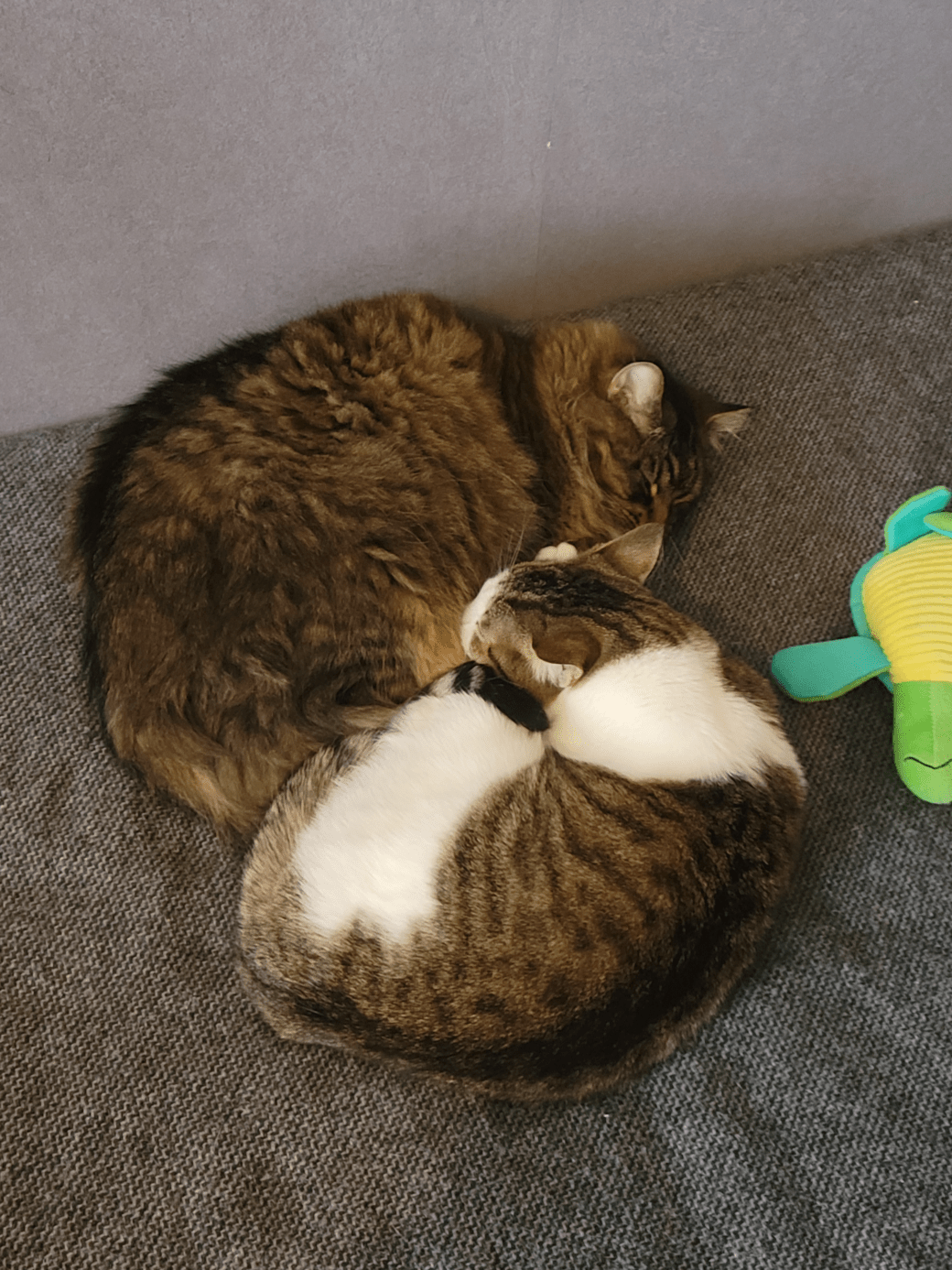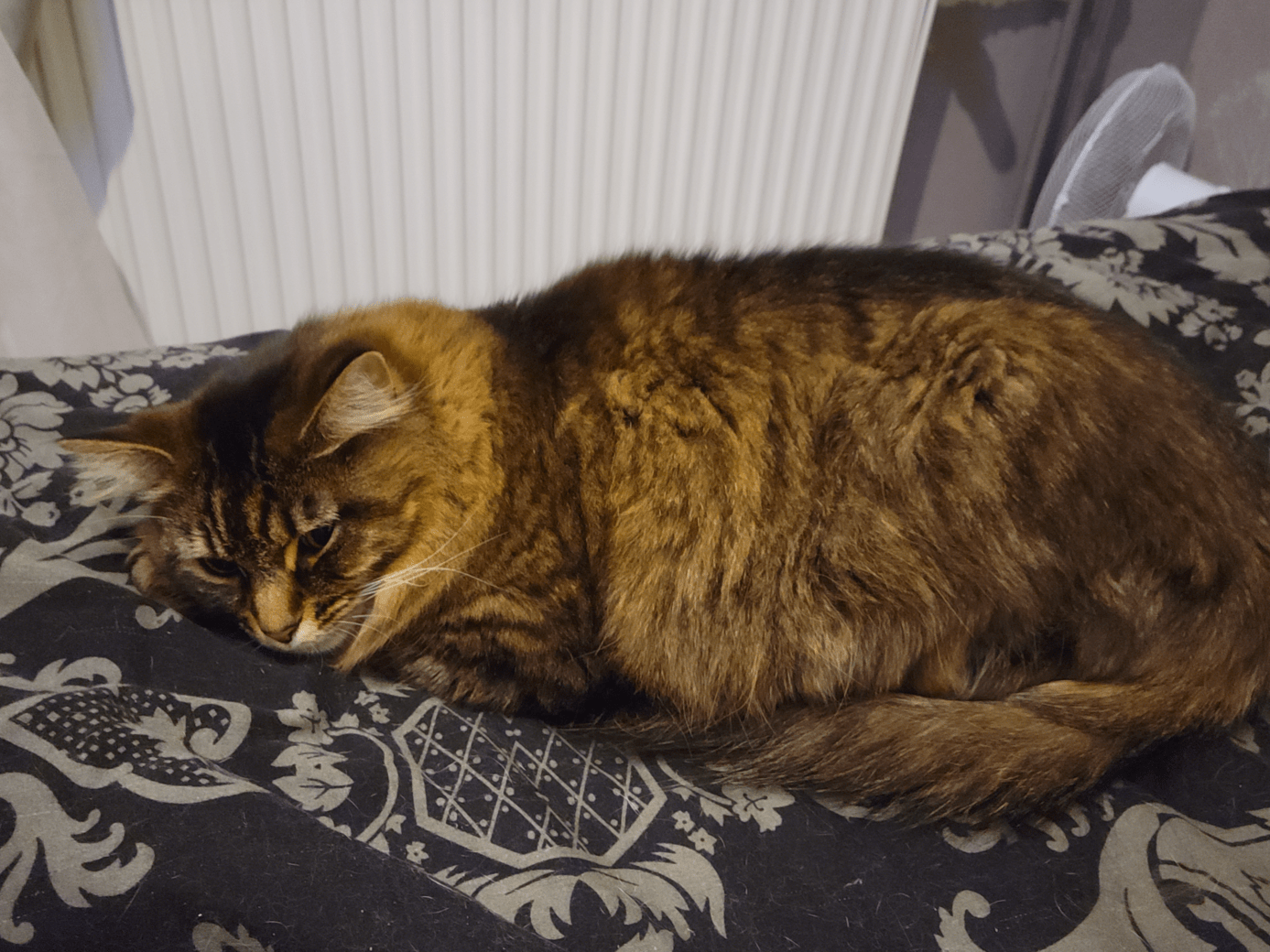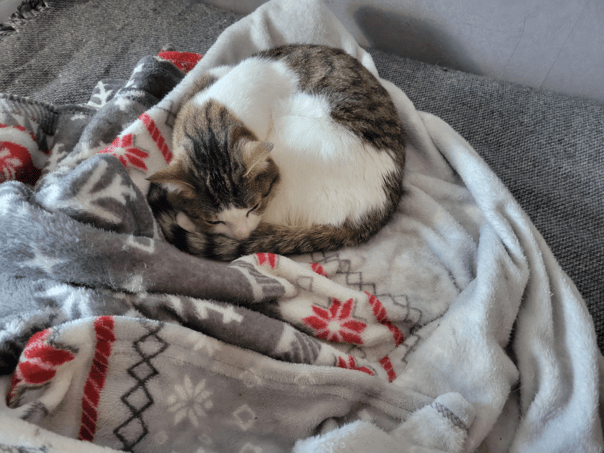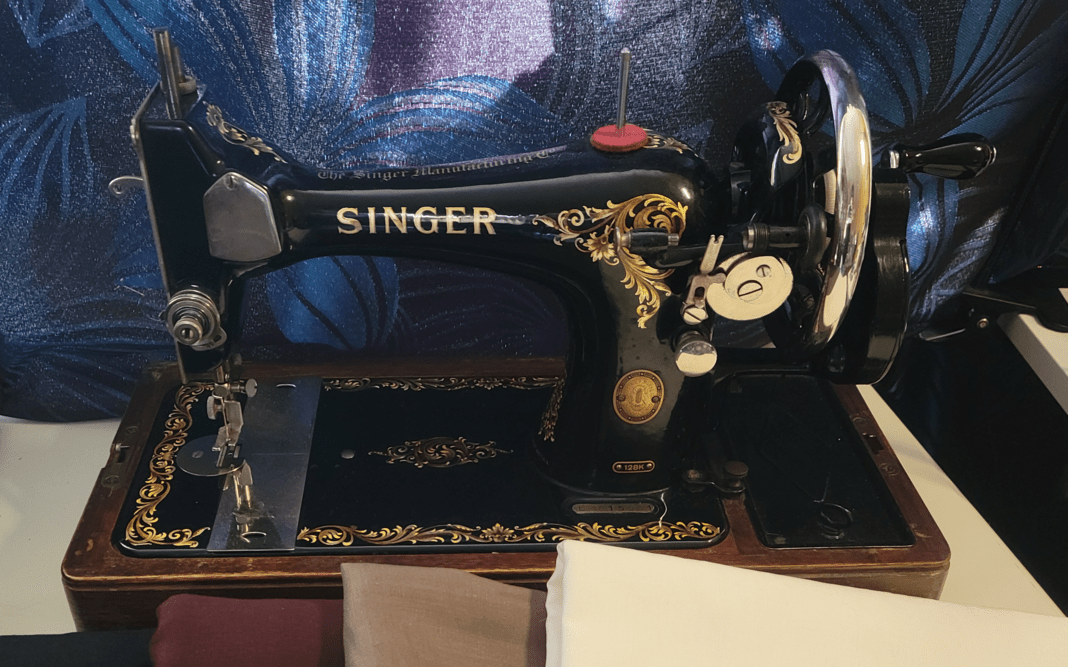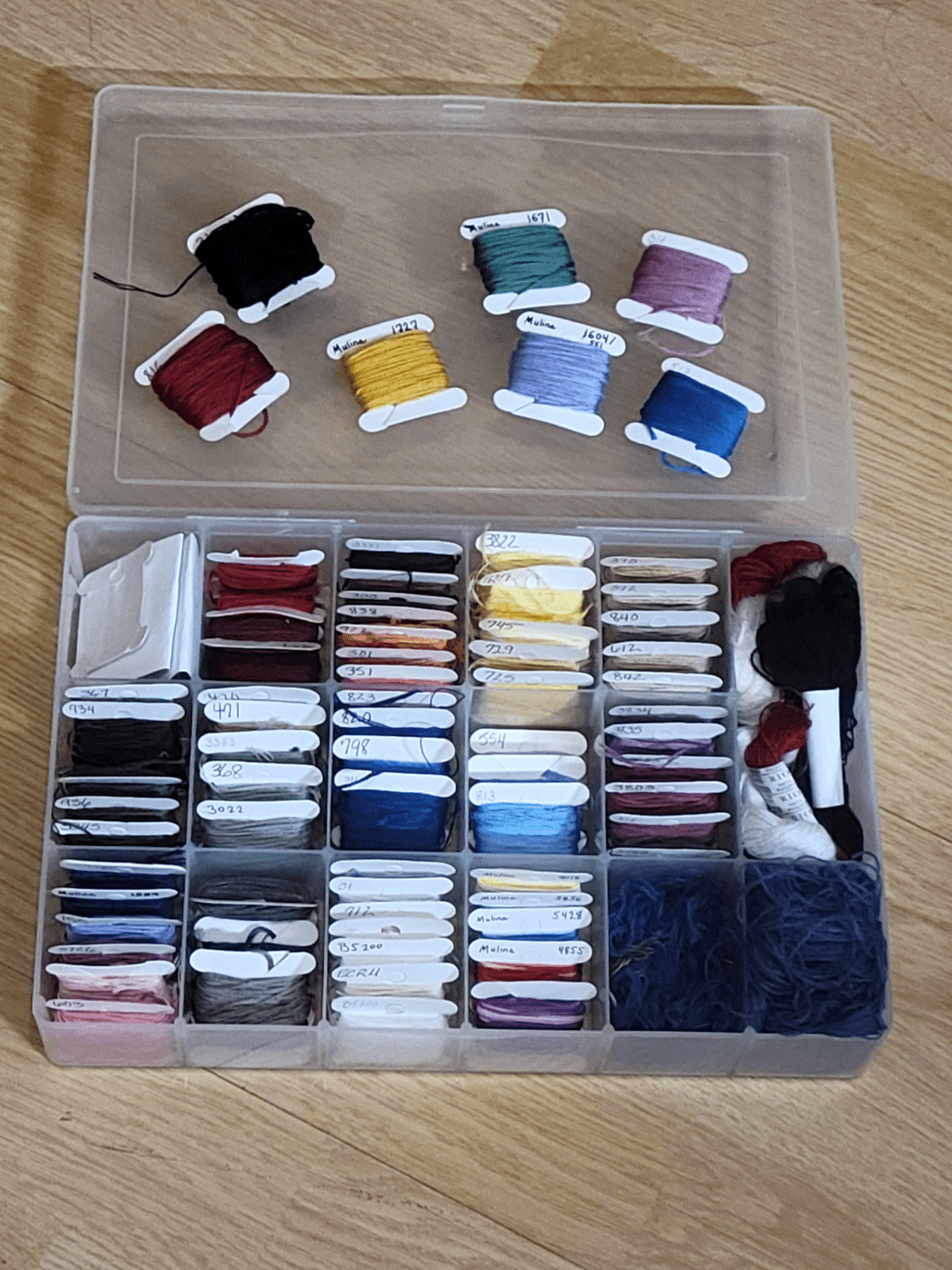Tools
While making my folk dress, I thought it would be interesting to make a page detailing the tools and materials that I used. I especially wanted to make a section for this so that I could talk about Bonnie, since she is a critical part of sewing both my opynka and vyshyvanka. So, below I have listed the various things I used to make my dress and some background stories behind them.
Lali & Laila
So… I guess these two can be categorized as “material.” I thought it would be funny to place them in this section, especially because I’ve called them my “sewing assistants” before. Of course, they don’t actually help sew; instead, they usually stop the sewing process by laying on the fabric. Lali & Laila are both COVID kitties. They were born around April or May 2020, and I adopted them from the animal shelter in Bloomington, IN in mid-August 2020. I’m really fortunate that I was able to bring them with me when I moved to Estonia.
Lali is part Maine Coon, part American longhair. For having such long, dark fur, luckily, she doesn’t shed too much. Lali, in general, doesn’t know what’s going on at any given moment, but she is very affectionate. She loves people and is very pet-motivated. At 6.8kg / 15lbs, she does take up a fair amount of space. Her hobbies include looking out the window, asking for pets, and lying on my desk (effectively taking up 75% of its space).
Laila is a normal shorthair cat, but she’s also a princess. Laila is exactly half of Lali’s size, but she’s 10x more demanding and loud. Before I adopted her, Laila lived with a very attentive older woman, and she is still a lap kitty to this day. This is great, until I’m trying to sew or embroider and find that her white fur is everywhere. Approximately 1/4th of my folk dress is actually Laila’s fur. Besides shedding fur, her other hobbies include looking at humans with disdain, chirping at birds, and meowing between the hours of 3pm and 3am.
Both Lali and Laila were critical to have while constructing my folk dress. I recommend trying to find similar assistants for other crafters.
Bonnie
Meet Bonnie! Bonnie is the sewing machine that I am using for my folk dress (the opynka and vyshyvanka, specifically).
Bonnie is a vintage Singer sewing machine. She was issued on 19 September 1957. She is a model 128k, one of 10,000 issued that day, and was most likely manufactured in Scotland. Bonnie is particularly special because she is a hand-crank sewing machine, meaning that she is entirely hand-powered. I turn the hand crank with my right hand, her needle bobs up and down, and I control the fabric with my left hand. Here’s a video of someone operating an older version of Bonnie (even with the same decals!).
While Bonnie’s first 65 years of existence are unknown to me, at some point she was refurbished and donated to a UK charity, which then sold her on eBay. The organization estimated her year of manufacture to be 1929, which is a valid guess, but the serial number database places her in 1957. Ah well. Regardless, they sold Bonnie for an agreeable price, and she was clearly in great working condition, so I purchased her in August 2022, roughly a month after I moved to Estonia. Bonnie has been my primary sewing machine since moving to Estonia; I have no other working sewing machines at the moment (though I do have a Soviet-era hand crank also from the ‘50s that I’m restoring).
You may be wondering why I call her Bonnie. Well, if I’m going to be working with her closely, I wanted to name her. I don’t normally do this sort of thing, but Bonnie is a very good sewing machine. Since she was manufactured in Scotland, I wanted to give her a Scottish name and turned to a good friend of mine in the US who researches Scottish history. My friend suggested “Bonnie” as a strong Scottish name, and she’s been Bonnie ever since!
Okay, the actual question tends to be, Why the hell do I have a hand crank? Experienced seamstresses tend to give me a look when I tell them this.
I don’t quite remember when I learned how to hand sew. When I was a kid, my dad was an industrial seamstress (mostly dog beds, etc.), and my mom was a costume seamstress (mostly historical costumes for local plays). At some point when I was perhaps 4, someone bought me a little sewing kit – a black box with white dots and a poodle on the front. I’m fairly certain my mom was the one to teach me how to hand sew. And I really enjoyed it! I enjoyed it enough that when I was 8, I asked if I could learn how to sew on the machine. My (long-separated) parents decided this was a 2-person job… that was a mistake. Both had completely different opinions on how I should learn, and my experience with the sewing machine quickly became confusing. As I’ve gotten older, I’ve also found them to be much too loud for my frequent migraines. So, while I still remember how to sew on the simpler machines, I prefer to avoid them altogether.
If I sewed after that, I stuck with hand sewing. That is, until ~2021, when I discovered that hand crank sewing machines were still a thing that existed. I watched tons of videos about them after that, learning about how they worked and how to sew on them exactly. I was able to get a working one while I was still living in the US and found that I enjoyed working with the hand crank much more than electric sewing machines. That hand crank sewing machine is still with my mom. But at this point, I’ve worked with Bonnie more than any other sewing machine.
Are there downsides? Sure! Bonnie can be pretty slow in comparison to a motor, and she’s rather heavy to carry (13.4kg / 30lbs). I also find it difficult to move the fabric in a perfectly straight line with just my left hand. I discuss this on the opynka page as well, but it’s difficult to get perfectly neat stitches on Bonnie when working with heavier fabrics. The fact that she is on a platform combined with having to crank the machine means that I have to both support and guide heavier fabric with my non-dominant hand. It’s not easy! I would love to work with a treadle someday, simply so that I don’t have to worry about controlling the weight of heavier fabrics.
But in the meantime, I genuinely like working with a hand crank. Part of that is that I just like older technology in general – my other prized technology is my Walkman from 1978! There’s a certain reassurance in knowing that Bonnie will stand the test of time, just as long as I take proper care of her. It’s reassuring that she’s made of metal and wood instead of plastic, like most modern machines. And that if she ever breaks, there’s a reasonable chance that I can find a replacement part and repair her myself. I like that she’s so quiet that I can hear the little click when the needle moves. I like that I power her because it means that I can physically feel how much resistance the fabric may or may not give while pushing the crank. A hand crank is the closest you can get to really feeling the needle push through the fabric without hand sewing. A hand crank sewing machine is certainly unappealing to the modern seamstress, but I adore her.
And I will give one final endorsement for Bonnie: she invokes memories. I’m proud of Bonnie; I like to show her off. And when I talk to people my age about hand crank sewing machines, it often elicits memories and stories. I’ve had so many people (in the US, Poland, Estonia, etc.) light up when I mention them and tell me how their grandma/etc. had a hand crank or treadle machine when they were growing up – my mom included! Younger men, in particular, get really excited to look up the sewing machines their grandparents had and show me the photos. For a machine as “obsolete” as Bonnie, she carries so many pleasant memories for people. So, there are a lot of reasons why Bonnie is not just my working sewing machine but one of my most beloved possessions.
My Embroidery Kit
There are 2 sentimental possessions from my mom that I’ve had for several years. One is a collection of pitchers that she got in the 1980s. The other is an embroidery kit that she gave me when I was ~16 and first got really interested in embroidery – so I’ve had this kit for over a decade now. This kit includes a plastic organizer, several paper cards, several colors of DMC cotton embroidery floss (~50), and a bunch of embroidery needles. A lot of the cards and floss are the same ones that my mom gave me, though I’ve had to replace red (816) & black (31) frequently and have added more over the years. My embroidery needles are the same that she bought me; I’ve never replaced them.
At the time, my mom was working 2 jobs. The first job was as a professional costume seamstress for local plays. In 2007, she was awarded as the best costume seamstress in North America and the UK – she’s a really skilled seamstress. But it was an extremely low-paying job and was never enough in California. So, her 2nd job was selling sewing machines at Joann Fabric & Crafts, at which she got a discount for things like embroidery floss organizers.
For these types of embroidery kits, you have to label the cards and wind all the floss onto the cards yourself. She wound and labeled all the cards for me before giving me the kit and teaching me all the embroidery stitches that she knew. I’m still very proud of the fact that I taught her how to embroider the French knot a few years later.
I always bring my embroidery kit when I move – first to Indiana, now to Estonia. It lives permanently wherever my workspace is, within reach whenever I need it. Of course, I have to find my own floss and label my own cards now. I tend to use both DMC and Mulina at this point. I did obtain some of the Mulina floss that I used for my vyshyvanka (at least 1727 and 316) from a craft supply store while visiting Kolomyia in July 2023, while the rest was either already in my possession from the US or purchased in Estonia.
Anyway, I’m sure the most relevant information for the reader is my floss information:
-
Black: DMC 310 / Mulina 1819
-
Red for shoulder inset: DMC 816
-
Dark red for cuffs: Mulina 1572
-
Gold: Mulina 1727
-
Blue: DMC 517
-
Green: Mulina 1671
-
Pink: DMC 316
-
Purple: Mulina 1604/551
Hoops
I used 2 different types of hoops while embroidering. One hoop was a normal wooden circle hoop, probably 8” / 20cm in diameter. I’ve had it hanging around for a while now, to the point where I couldn’t even tell you when I acquired it; it’s my standard hoop whenever I embroider. This is the one I used to embroider my cuffs on.
As you might imagine, my regular hoop is not sufficient for the full inset of 12” / 30.5cm wide embroidery on my sleeves. I tried to tolerate it at first, but I was constantly having to re-hoop my embroidery. It is very, very annoying when you’re constantly interrupted to adjust when working on a larger piece of embroidery. About halfway through my first sleeve, I gave up entirely and got a square embroidery frame from a local crafts store (Kunst & Hobi).
The one I found is from the UK and… horrible to work with. I hate the damn thing. First off, it’s cheap, as evident by the fact that the plywood is already splitting. Second, because it’s not wide enough for my fabric to sit properly, I have to fold the fabric over itself just to fit it into the maximum width. This could be solved by getting a larger frame, of course, but those are rather expensive on a student budget, and I’m not currently capable of making my own. Perhaps I would like the whole idea better if I could make my own. However, I also really hate fixing my fabric on it – I do not look forward to getting the fabric to sit straight on it and then sewing the fabric into the frame. I find it more tedious than the normal circle hoop. But it also allows me to embroider for a longer time without interruption. So… I don’t know. Me and the square frame are in a love-hate relationship. I’m hoping to find a better solution before making another vyshyvanka in the future.
Bead Loom
Bead loom and I are also in a complicated relationship, though not nearly to the same extent as with the embroidery frame. I purchased the bead loom from an Etsy seller with the understanding that the seller produced them. What I got was a boxed child’s kit that also originated from the UK. Not ideal!
Anyway, my bead loom is made from pressed plywood and has 2 metal springs at either end to warp the loom. It’s rather small, as the working space is only 23cm x 30cm / 9” x 11.8”. Luckily, the 2 bars at either end are also adjustable, increasing the length of the working space and allowing me to make my silyanka on the little loom. It was also cheap (~30 euros) and allowed me to try out bead weaving for the first time, so I really can’t complain too much. My little bead loom gave me a chance to learn this skill and see if I actually liked it, so it did its job well enough.
It is rather cramped, though, and would be a nightmare to make a gerdan on. When I’m ready to pick up bead weaving again, I’ll probably follow the example of the Ukrainian beadworker I got to meet in Tallinn and purchase one of the better-designed modern bead looms. After seeing how this one actually works, it’s the only one I’d readily recommend for those interested in learning.
Linen Fabric
My vyshyvanka is made out of white linen fabric. I already possessed some white linen before starting on my vyshyvanka but ended up purchasing a new length of linen to make sure I had enough upfront. Luckily, a good amount of linen in Estonia is fairly priced by US standards – I paid around 10 euros for more than I needed to make a vyshyvanka. I do tend to buy remnants (the leftover pieces of fabric from a full bolt), so I can’t say much more about the company/etc.
I’ve worked with linen in my embroidery before, so this wasn’t anything new. I’m fond of the fact that it is environmentally friendly and usually easy to work with, as long as I have a hoop. I find the preparation and ironing process exceedingly tedious, as I imagine most people do. And embroidering on linen can get annoying when the lighting isn’t quite right; most of my stitches for the vyshyvanka are counted stitches, so if I can’t count the linen threads, then I can’t embroider. This was only a problem when Laila decided to sit in my lap, though, so what can you do?
The thread I used was of the cotton sort one can find in any store. Mez Duet from Hungary was what I typically used for sewing. Is there better? Obviously. If I were hand sewing, I would have considered using linen thread, which is the more traditional choice, but I have no idea how Bonnie would take linen thread, and I didn’t care to go through that trial-and-error. So, cotton thread was the preferred choice.
Wool Fabric
I think this is the last thing I need to list. I used a good bit of wool fabric when I made my opynka. I describe this fabric in-depth on my opynka page, so I’ll keep it brief here.
I didn’t personally purchase this fabric. When I moved to Estonia, I ended up inheriting a lot of fabric from my friend, fellow crafter Mathilde. Among her fabrics was a remnant of red & black wool fabric that suited me well enough. I’m not entirely sure that it’s 100% wool (nor am I eager to do the burn test to try), but I’m fine with it at least being a wool blend. It was free and suitable for this project, so I’m not going to complain.
Incidentally, the button I used for the opynka was also inherited from Mathilde. This is a rather large wooden button that may be found in quite a few tourist shops around Estonia. And I hand-sewed the buttonhole with a bit of black silk thread that I purchased while visiting Wolin, Poland. Okay, now that must be it for sure!
